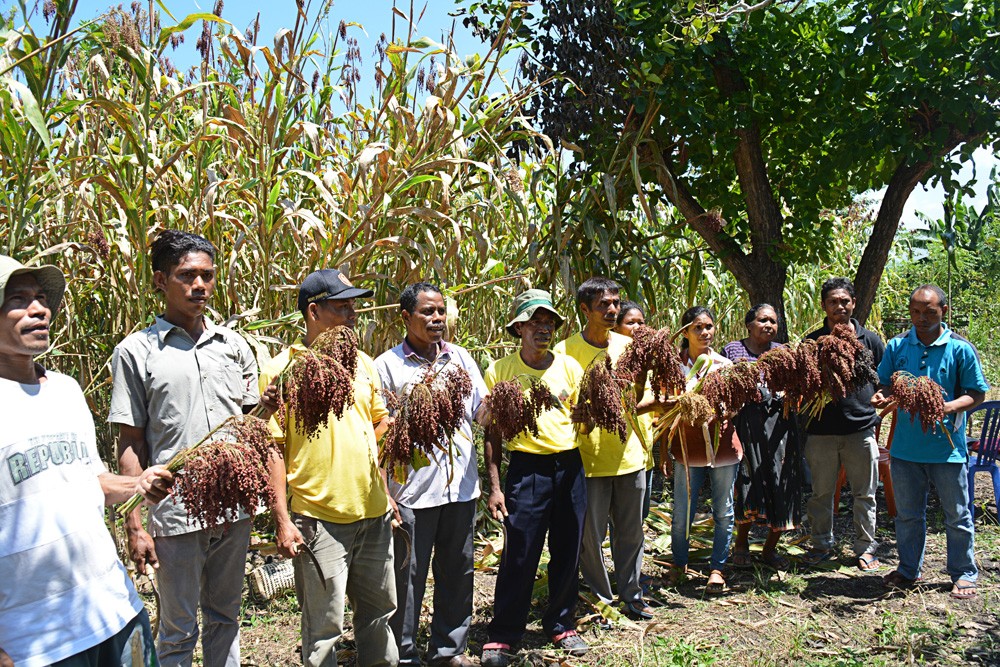Helena Nanung, a female sorghum farming pioneer from E. Nusa Tenggara
Change text size
Gift Premium Articles
to Anyone
 Harvest time – Helena Nanung (third from right), 65, and several farmers show the red sorghum grain they just have harvested from their field in Kampung Sambir, Wae Mose village, South Lembor district, West Manggarai, Flores, East Nusa Tenggara, recently. (thejakartapost.com/Markus Makur)
Harvest time – Helena Nanung (third from right), 65, and several farmers show the red sorghum grain they just have harvested from their field in Kampung Sambir, Wae Mose village, South Lembor district, West Manggarai, Flores, East Nusa Tenggara, recently. (thejakartapost.com/Markus Makur)
D
espite her worn out body, Helena Nanung, 65, seemingly has not lost spirit in cultivating sorghum as feedstock in Kampung Sambir, Wae Mose village, South Lembor district, West Manggarai regency in Flores, East Nusa Tenggara (NTT).
“I’m old but I’m still driven to cultivate red and white sorghum in Kampung Sambir. My forefathers and parents used to cultivate white sorghum. Me and my siblings used to eat sorghum during our childhood before the government introduced its paddy farming program across the region,” Nanung told thejakartapost.com in a recent visit. Two sorghum varieties, namely nipon and raja, were among the most popular varieties cultivated in her village, she further said.
Nanung said it was the sorghum cultivating program developed by the Lembor Farmers Alliance (APEL) that inspired her to cultivate sorghum on her approximately half-a-hectare plot of land. “Its program led our people to turn [the crop] into a local food source and gave me the inspiration to cultivate sorghum,” she said.
Working together with her colleagues from farming group Mekar Karya Sambir, Nanung planted sorghum seeds provided by the alliance on her land. She said it was much easier to cultivate sorghum than paddy because sorghum could be planted on critical land and it did not need a lot of water.
Unlike planting paddy, Nanung said, cultivating sorghum did not need chemical fertilizers and anti-plant disease did not need to be sprayed as sorghum was a pest-resistant plant, and thus, sorghum cultivation was cost-efficient. While its grains were widely used as a healthy alternative to white rice, other parts of the sorghum plant, such as its leaves and stalks, could be used as cattle feed.
Nanung further explained few people in Flores suffered from disease because they consumed a diet rich in healthy carbohydrates such as sorghum, cassava and corn. After the widespread consumption of rice white, many people got illnesses as its refining process had removed much of its nutritional elements.
Nanung said cultivating sorghum had also helped improve the economy of people in her village.
“I lead a micro-lending cooperative [UBSP], which has brought benefits to hundreds of women in Kampung Sambir. With 22 people as its official members, the UBSP has helped finance the education of children in Kampung Sambir, from elementary schools to universities,” said Nanung, who obtained only an elementary school education and graduated in 1964.
With her sorghum planting activities, Nanung also could send her six children from her marriage with Gaspor Arom to better schooling. Their eldest daughter has become a nun and has been assigned to religious service in Austria.
Nanung said it was “dodo”, a community self-help culture in West Manggarai that had helped her success in developing sorghum farming programs in her area. With “dodo”, farmers did not have to spend money to hire workers because they took turns in working their land. “This culture has been maintained well by female farmers here and this has helped ease their work on the fields,” said Nanung. (ebf)









